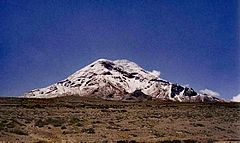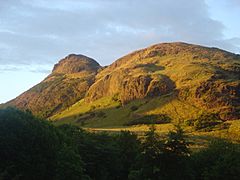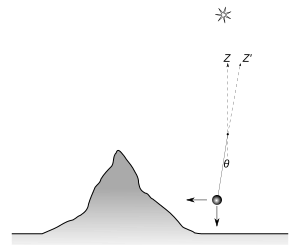Schiehallion experiment facts for kids
The Schiehallion experiment was an important science project from the 1700s. Its main goal was to figure out how dense the Earth is. Imagine trying to weigh the whole planet! This experiment happened in the summer of 1774 in Scotland, near a mountain called Schiehallion.
Scientists used a special tool called a pendulum. They watched how the mountain's gravity slightly pulled the pendulum. This tiny pull, or "deflection," helped them calculate the Earth's density. Schiehallion was chosen because it was alone and had a nice, even shape. This made the measurements easier.
A famous scientist, Isaac Newton, had thought about this experiment before. But he believed it would be too hard to measure. However, a team led by Nevil Maskelyne, the King's main astronomer, thought they could do it. If they could figure out the mountain's density and size, they could then find the Earth's density. Knowing the Earth's density would also help them estimate the densities of other planets, their moons, and even the Sun!
Contents
How the Experiment Worked
Imagine a pendulum hanging perfectly straight down. It points towards the center of the Earth. But if a very big object, like a mountain, is nearby, its gravity will gently pull the pendulum. This makes the pendulum swing slightly away from pointing straight down.
Scientists could measure this tiny change in the pendulum's angle. They would do this by comparing it to a known point, like a star. They would take measurements on both sides of the mountain.
If they knew the mountain's size and could guess the average density of its rocks, they could use this information. They would then use these numbers to figure out the average density of the whole Earth. Once they knew the Earth's density, they could also estimate its total mass.
Isaac Newton had thought this experiment would be too difficult. He believed mountains were too small to cause a noticeable pull. He thought gravity's effects were only clear on a planetary scale. But Newton was wrong! Even though the pull was tiny (less than 2 minutes of arc), it was possible to measure with the tools they had back then.
This experiment would help prove Newton's ideas about gravity. It would also give scientists the first good estimates for the mass and density of Earth. This was a big deal because, before this, they only knew the relative sizes of planets.
Finding the Right Mountain

Early Attempts: Chimborazo, 1738
Two French astronomers, Pierre Bouguer and Charles Marie de La Condamine, tried a similar experiment first. They did their work on a huge volcano called Mount Chimborazo in South America in 1738. They were already there to measure the Earth's shape near the equator.
They took measurements in very tough conditions, high up on the mountain. Bouguer later wrote that they saw a tiny pull of 8 seconds of arc. But he felt the experiment would be better done in an easier place. Still, their attempt showed that the Earth was not a hollow shell, as some people thought.
Schiehallion, 1774

In 1772, Nevil Maskelyne, the King's Astronomer, suggested trying the experiment again. He told the Royal Society that it would "do honour to the nation." He suggested mountains in England, like Whernside.
The Royal Society created a special committee to look into it. They sent an astronomer named Charles Mason to find the perfect mountain.
After a long search in 1773, Mason found Schiehallion. This mountain is 1,083 meters (3,553 feet) tall. It sits between two lochs (lakes) in the Scottish Highlands. Schiehallion was perfect because it was far from other hills. This meant other hills wouldn't mess up the gravity measurements. Its even east-west ridge also made calculations simpler. Its steep sides allowed the scientists to set up close to its center.
Mason didn't want to do the work himself. So, the job went to Maskelyne. He was helped by Charles Hutton and Reuben Burrow. They hired workers to build small observatories and help with the surveying.
The team had excellent tools. They used a 12-inch brass quadrant from James Cook's famous voyage. They also had a 10-foot zenith sector and a very accurate clock. For mapping the mountain, they used a theodolite and a Gunter's chain. They even had barometers to measure height. The experiment had plenty of money because King George III gave them leftover funds from a previous expedition.
Taking Measurements
Astronomical Observations
Scientists built small observatories on the north and south sides of the mountain. They also built a small hut for their equipment. Most of the workers lived in tents. Maskelyne started by making astronomical measurements. He needed to find the exact angle of stars when they passed due south.
The weather was often bad, with mist and rain. But Maskelyne still managed to take many measurements. He took 76 measurements of 34 stars from the south observatory. He also took 93 observations of 39 stars. From the north side, he took 68 observations of 32 stars and 100 observations of 37 stars. He was very careful to avoid mistakes in his measurements.
To find the mountain's pull, Maskelyne had to consider the Earth's curve. As you move north or south, the local "straight down" direction changes. After accounting for other effects, Maskelyne found that the difference in the "straight down" direction between the north and south observatories was 54.6 arc seconds.
The surveying team found that the two observatories were 42.94 arc seconds apart in latitude. By subtracting this, Maskelyne announced that the mountain had pulled the pendulum by 11.6 arc seconds in total.
Maskelyne shared his first results in 1775. He used early information about the mountain's shape. He expected a pull of 20.9 arc seconds if the mountain and Earth had the same density. Since the actual pull was about half of that, he announced that the Earth's average density was roughly double that of Schiehallion. More exact numbers would come later.
Maskelyne also noted that Schiehallion clearly had a gravitational pull. This meant all mountains did. And it confirmed Newton's law of gravity. The Royal Society gave Maskelyne a special medal for his work. People said that any doubts about Newton's ideas were now gone.
Surveying the Mountain
The surveying team faced many challenges due to the bad weather. It took them until 1776 to finish their work. To find the mountain's volume, they had to divide it into many vertical sections. Charles Hutton had a huge job. The surveyors had taken thousands of measurements from over a thousand points around the mountain.
To make sense of all this data, Hutton came up with a brilliant idea. He drew lines connecting points of equal height. These lines are now called contour lines. They are commonly used on maps today to show how high the land is. This helped him easily figure out the height of each section of the mountain.
| Body | Density, kg·m−3 | |
|---|---|---|
| Hutton, 1778 | Modern Value | |
| Sun | 1,100 | 1,408 |
| Mercury | 9,200 | 5,427 |
| Venus | 5,800 | 5,204 |
| Earth | 4,500 | 5,515 |
| Moon | 3,100 | 3,340 |
| Mars | 3,300 | 3,934 |
| Jupiter | 1,100 | 1,326 |
| Saturn | 410 | 687 |
Hutton then had to calculate the gravitational pull from each of these many sections. This took him another two years! In 1778, he presented his findings. He found that the Earth's pull on the pendulum would be 9,933 times stronger than the mountain's pull. This was if the Earth and mountain had the same density.
But the actual measured pull of 11.6 arc seconds meant a different ratio. After accounting for other factors, the ratio was 17,804:1. This meant the Earth's average density was about 9/5 times that of the mountain. Hutton estimated Schiehallion's density to be 2,500 kg per cubic meter. So, he calculated the Earth's density to be 4,500 kg per cubic meter.
Today, we know the Earth's density is about 5,515 kg per cubic meter. So, Hutton's calculation was less than 20% off! This was incredibly accurate for the time.
The fact that the Earth's average density was much higher than its surface rocks meant something important. It showed that there must be much denser material deep inside the Earth. Hutton correctly guessed that the Earth's core was probably made of metal. He thought it might have a density of 10,000 kg per cubic meter. He also estimated that this metallic core made up about 65% of the Earth's diameter.
With the Earth's density known, Hutton could then add actual density values to the tables of planets. Before this, scientists only knew the relative densities of objects in our solar system.
Later Experiments
Twenty-four years after the Schiehallion experiment, in 1798, Henry Cavendish did an even more accurate measurement. He used a very sensitive tool called a torsion balance. He measured the tiny pull between large lead balls.
Cavendish found the Earth's density to be 5,448 kg per cubic meter. This was only 1.2% different from today's accepted value! His result was not significantly improved until 1895. Because of his careful work, this experiment is now known as the Cavendish experiment.
John Playfair did another survey of Schiehallion in 1811. He suggested a slightly higher density for the Earth, between 4,560 and 4,870 kg per cubic meter. But this was still lower than Cavendish's earlier result.

The Schiehallion experiment was repeated in 1856 by Henry James. He was the director of the Ordnance Survey. He used a hill called Arthur's Seat in Edinburgh. With all the resources of the Ordnance Survey, he surveyed a much larger area. He found the Earth's density to be about 5,300 kg per cubic meter.
In 2005, a new experiment tried a different approach on Schiehallion. Instead of measuring the pendulum's angle, they compared how fast a pendulum swung at the top and bottom of the mountain. A pendulum swings slower at higher altitudes. But the mountain's mass would reduce this difference. This experiment was easier to do than the 1774 one. It found the Earth's mass to be about 8.1 ± 2.4 × 1024 kg. This meant a density of 7,500 ± 1,900 kg per cubic meter.
In 2007, scientists re-examined the old data using modern computers. They had much better maps and knowledge of Schiehallion's geology. They calculated the Earth's average density to be 5,480 ± 250 kg per cubic meter. This was very close to the modern value of 5,515 kg per cubic meter. It showed how incredibly accurate Maskelyne's original observations were!
Images for kids
See also
 In Spanish: Experimento de Schiehallion para niños
In Spanish: Experimento de Schiehallion para niños



